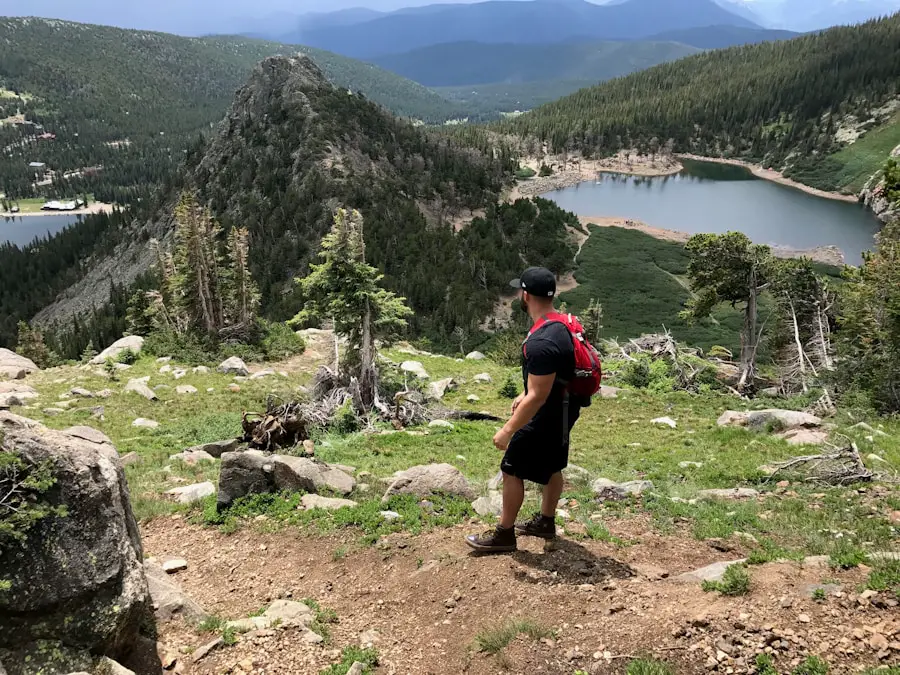Hiking is a beloved outdoor activity that allows individuals to connect with nature, enjoy breathtaking views, and engage in physical exercise. However, the joy of traversing scenic trails can sometimes be overshadowed by the onset of hip pain after a hike. This discomfort can range from mild soreness to debilitating pain, impacting one’s ability to walk or engage in other activities.
Understanding the intricacies of hip pain post-hiking is essential for both avid hikers and casual walkers alike, as it can help in identifying the underlying causes, symptoms, and effective management strategies. The hip joint is a complex structure that bears significant weight and facilitates a wide range of motion. It is composed of bones, cartilage, ligaments, and muscles that work in harmony to support movement.
When subjected to the rigors of hiking—such as uneven terrain, steep inclines, and prolonged periods of activity—this joint can experience stress and strain. Consequently, recognizing the signs of hip pain and understanding its implications can empower hikers to take proactive measures to protect their joints and enhance their overall hiking experience.
Key Takeaways
- Hip pain after hiking is a common issue that can be caused by a variety of factors, including overuse, muscle strain, or underlying medical conditions.
- Common causes of hip pain after hiking include muscle strain, overuse injuries, bursitis, arthritis, and hip impingement.
- Symptoms of hip pain post hiking may include aching or sharp pain in the hip or groin area, stiffness, swelling, and difficulty walking or bearing weight on the affected hip.
- To prevent hip pain after hiking, it is important to warm up properly, use proper hiking gear, maintain good posture, and gradually increase intensity and duration of hikes.
- Treatment options for hip pain post hiking may include rest, ice and heat therapy, over-the-counter pain medication, physical therapy, and in severe cases, surgery.
Common Causes of Hip Pain After Hiking
Several factors can contribute to hip pain following a hike, with overuse injuries being among the most prevalent. Overuse injuries occur when the hip joint is subjected to repetitive stress without adequate recovery time. This is particularly common in individuals who may not be accustomed to long hikes or who suddenly increase their hiking intensity or duration.
Conditions such as tendinitis, bursitis, or iliotibial band syndrome can arise from this overexertion, leading to inflammation and pain in the hip area. Another common cause of hip pain post-hiking is improper footwear. Hiking boots that do not provide adequate support or cushioning can lead to misalignment and increased strain on the hip joint.
Additionally, hiking on uneven or rocky terrain can exacerbate this issue, as it requires the body to compensate for instability. Poorly fitting shoes can also lead to blisters and other foot injuries, which may alter one’s gait and place additional stress on the hips. Therefore, selecting appropriate footwear is crucial for preventing hip pain during and after hikes.
Symptoms of Hip Pain Post Hiking

The symptoms of hip pain after hiking can vary widely depending on the underlying cause and severity of the condition. Commonly reported symptoms include a dull ache or sharp pain in the hip joint, which may radiate down the thigh or into the groin area. Individuals may also experience stiffness in the hip joint, particularly after prolonged periods of rest or inactivity.
This stiffness can make it challenging to resume normal activities following a hike. In some cases, individuals may notice swelling or tenderness around the hip joint, which can be indicative of inflammation. Affected individuals might also experience a decreased range of motion in the hip, making it difficult to perform everyday tasks such as climbing stairs or getting in and out of a vehicle.
In more severe cases, hip pain may be accompanied by a clicking or popping sensation during movement, which could signal underlying structural issues within the joint itself.
Prevention and Precautions for Hip Pain After Hiking
| Prevention and Precautions for Hip Pain After Hiking |
|---|
| 1. Proper warm-up and stretching before hiking |
| 2. Use trekking poles to reduce impact on hips |
| 3. Wear proper footwear with good ankle and arch support |
| 4. Maintain a healthy body weight to reduce strain on hips |
| 5. Stay hydrated and take regular breaks during the hike |
| 6. Incorporate hip-strengthening exercises into your fitness routine |
| 7. Avoid overexertion and listen to your body’s signals |
Preventing hip pain post-hiking begins with proper preparation before hitting the trails. One of the most effective strategies is to gradually increase hiking intensity and duration over time. This allows the body to adapt to the physical demands of hiking, reducing the risk of overuse injuries.
Additionally, incorporating strength training exercises that target the muscles surrounding the hip joint can enhance stability and support during hikes. Choosing appropriate footwear is another critical aspect of prevention. Hikers should invest in high-quality boots that provide adequate arch support, cushioning, and fit well to prevent blisters and misalignment.
It is also advisable to break in new hiking shoes before embarking on long treks to ensure comfort and reduce the risk of injury. Furthermore, paying attention to trail conditions and selecting routes that match one’s fitness level can help mitigate the risk of hip pain.
Treatment Options for Hip Pain Post Hiking
When hip pain does occur after hiking, several treatment options are available to alleviate discomfort and promote healing. Initially, applying ice to the affected area can help reduce inflammation and numb pain. Ice therapy should be applied for 15-20 minutes at a time, several times a day, especially within the first 48 hours following the onset of pain.
This simple yet effective method can provide significant relief for many individuals. Over-the-counter nonsteroidal anti-inflammatory drugs (NSAIDs), such as ibuprofen or naproxen, can also be beneficial in managing pain and reducing inflammation. However, it is essential to follow dosage recommendations and consult with a healthcare professional if symptoms persist or worsen.
In cases where conservative measures do not yield satisfactory results, physical therapy may be recommended. A physical therapist can design a personalized rehabilitation program that includes stretching and strengthening exercises tailored to address specific issues related to hip pain.
Rehabilitation and Recovery for Hip Pain After Hiking

Rehabilitation plays a crucial role in recovery from hip pain post-hiking. Once acute pain subsides, engaging in gentle stretching exercises can help restore flexibility and range of motion in the hip joint. Stretching exercises targeting the hip flexors, quadriceps, hamstrings, and glutes are particularly beneficial for promoting recovery.
For instance, performing a standing quadriceps stretch or a seated hamstring stretch can alleviate tightness in these muscle groups. In addition to stretching, strengthening exercises are vital for rebuilding muscle support around the hip joint. Resistance training using body weight or resistance bands can help improve muscle strength without placing excessive strain on the joint itself.
Exercises such as bridges, clamshells, and lateral leg raises are excellent choices for targeting the muscles that stabilize the hip. Gradually increasing intensity and incorporating low-impact activities like swimming or cycling can further aid recovery while minimizing stress on the hips.
When to Seek Medical Attention for Hip Pain Post Hiking
While many cases of hip pain post-hiking can be managed with self-care strategies, there are instances when seeking medical attention is warranted. If hip pain persists for more than a few days despite rest and home treatment measures, it may indicate a more serious underlying condition that requires professional evaluation. Additionally, if individuals experience severe pain that limits mobility or is accompanied by swelling, bruising, or fever, they should consult a healthcare provider promptly.
Other red flags include experiencing significant difficulty bearing weight on the affected leg or noticing any deformity in the hip area. These symptoms could suggest fractures or dislocations that necessitate immediate medical intervention. A healthcare professional may conduct imaging studies such as X-rays or MRIs to assess the extent of any injury and develop an appropriate treatment plan tailored to the individual’s needs.
Conclusion and Tips for Managing Hip Pain After Hiking
Managing hip pain after hiking involves a multifaceted approach that encompasses prevention strategies, treatment options, and rehabilitation techniques.
By understanding common causes and symptoms associated with hip pain, hikers can take proactive measures to protect their joints during outdoor adventures. Prioritizing proper footwear selection, gradually increasing hiking intensity, and incorporating strength training into one’s routine are essential steps toward preventing discomfort.In addition to these preventive measures, individuals should remain vigilant about their bodies’ signals during hikes. Listening to one’s body and recognizing early signs of discomfort can facilitate timely intervention before minor issues escalate into more significant problems. For those who do experience hip pain post-hiking, employing ice therapy, NSAIDs, and engaging in rehabilitation exercises can promote healing and restore function.
Ultimately, maintaining an active lifestyle while being mindful of joint health is key to enjoying hiking without the burden of persistent hip pain. By adopting these strategies and remaining informed about potential risks associated with hiking activities, individuals can continue to explore nature’s beauty while safeguarding their physical well-being.
After a long hike, it’s common to experience hip pain due to overuse or improper form. One related article that may provide insight into this issue is “Raccoons’ Homing Range: How Far Will They Travel?”. Just like raccoons have specific ranges they travel within, our hips have a limited range of motion and can become strained if pushed too far. Understanding the limits of our bodies and taking proper precautions can help prevent hip pain during and after hiking adventures.
FAQs
What causes hip pain after hiking?
Hip pain after hiking can be caused by a variety of factors, including overuse of the hip muscles, improper footwear, uneven terrain, poor hiking posture, or underlying hip conditions such as arthritis or bursitis.
How can I prevent hip pain while hiking?
To prevent hip pain while hiking, it’s important to wear proper footwear, use hiking poles for support, maintain good posture, stretch before and after hiking, and gradually increase the intensity and duration of your hikes to allow your hip muscles to adapt.
When should I seek medical attention for hip pain after hiking?
If your hip pain persists for more than a few days, is severe, or is accompanied by swelling, redness, or difficulty bearing weight, it’s important to seek medical attention. These symptoms could indicate a more serious injury or underlying hip condition that requires treatment.
What are some exercises to strengthen the hips for hiking?
Exercises such as hip bridges, clamshells, lateral leg raises, and squats can help strengthen the muscles around the hips, which can help prevent hip pain while hiking. It’s important to consult with a fitness professional or physical therapist to ensure proper form and technique.
